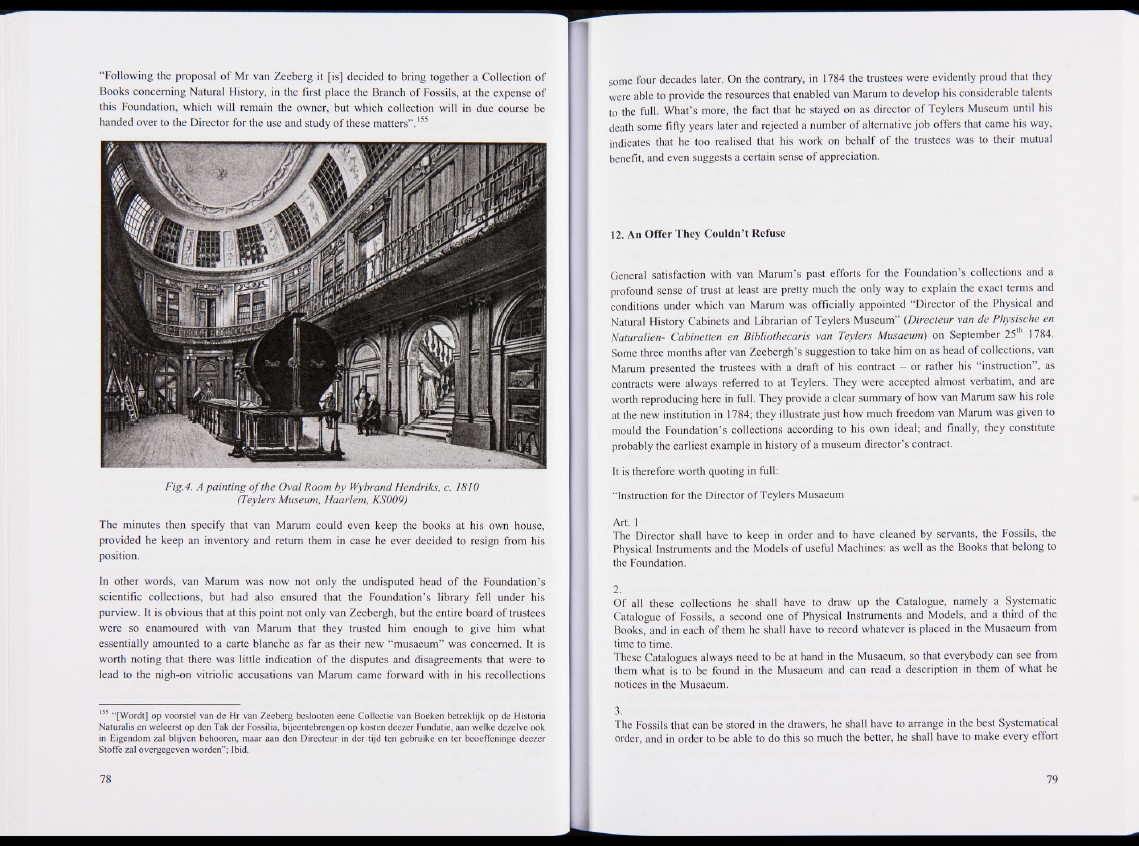
“Following the proposal of Mr van Zeeberg it [is] decided to bring together a Collection of
Books concerning Natural History, in the first place the Branch of Fossils, at the expense of
this Foundation, which will remain the owner, but which collection will in due course be
handed over to the Director for the use and study of these matters”.155
Fig. 4. A painting o f the Oval Room by Wy brand Hendriks, c. 1810
(Teylers Museum, Haarlem, KS009)
The minutes then specify that van Marum could even keep the books at his own house,
provided he keep an inventory and return them in case he ever decided to resign from his
position.
In other words, van Marum was now not only the undisputed head of the Foundation’s
scientific collections, but had also ensured that the Foundation’s library fell under his
purview. It is obvious that at this point not only van Zeebergh, but the entire board of trustees
were so enamoured with van Marum that they tmsted him enough to give him what
essentially amounted to a carte blanche as far as their new “musaeum” was concerned. It is
worth noting that there was little indication of the disputes and disagreements that were to
lead to the nigh-on vitriolic accusations van Marum came forward with in his recollections
155 “[Wordt] op voorstel van de Hr van Zeeberg beslooten eene Collectie van Boeken betreklijk op de Historia
Naturalis en weleerst op den Tak der Fossilia, bijeentebrengen op kosten deezer Fundatie, aan welke dezelve ook
in Eigendom zal blijven behooren, maar aan den Directeur in der tijd ten gebruike en ter beoeffeninge deezer
Stoffe zal overgegeven worden”; Ibid.
some four decades later. On the contrary, in 1784 the trustees were evidently proud that they
were able to provide the resources that enabled van Marum to develop his considerable talents
to the full. What’s more, the fact that he stayed on as director of Teylers Museum until his
death some fifty years later and rejected a number of alternative job offers that came his way,
indicates that he too realised that his work on behalf of the trustees was to their mutual
benefit, and even suggests a certain sense of appreciation.
12. An Offer They Couldn’t Refuse
General satisfaction with van Marum’s past efforts for the Foundation’s collections and a
profound sense of trust at least are pretty much the only way to explain the exact terms and
conditions under which van Marum was officially appointed “Director of the Physical and
Natural History Cabinets and Librarian of Teylers Museum” (Directeur van de Physische en
Naturalien- Cabinetten en Bibliothecaris van Teylers Musaeum) on September 25 1784.
Some three months after van Zeebergh’s suggestion to take him on as head of collections, van
Marum presented the trustees with a draft of his contract - or rather his “instruction”, as
contracts were always referred to at Teylers. They were accepted almost verbatim, and are
worth reproducing here in full. They provide a clear summary of how van Marum saw his role
at the new institution in 1784; they illustrate just how much freedom van Marum was given to
mould the Foundation’s collections according to his own ideal; and finally, they constitute
probably the earliest example in history of a museum director’s contract.
It is therefore worth quoting in full:
“Instruction for the Director of Teylers Musaeum
Art. 1
The Director shall have to keep in order and to have cleaned by servants, the Fossils, the
Physical Instruments and the Models of useful Machines: as well as the Books that belong to
the Foundation.
2. Of all these collections he shall have to draw up the Catalogue, namely a Systematic
Catalogue of Fossils, a second one of Physical Instruments and Models, and a third of the
Books, and in each of them he shall have to record whatever is placed in the Musaeum from
time to time.
These Catalogues always need to be at hand in the Musaeum, so that everybody can see from
them what is to be found in the Musaeum and can read a description in them of what he
notices in the Musaeum.
3.
The Fossils that can be stored in the drawers, he shall have to arrange in the best Systematical
order, and in order to be able to do this so much the better, he shall have to make every effort